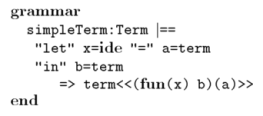Spatial logics are
specification logics for describing the behavior and
spatial structure of concurrent systems. Logics for
concurrent systems are certainly not new, but the intent
to describe spatial properties, and in particular the
spatial structure of distributed and mobile systems,
seems to have arisen only recently. The spatial
properties we consider are essentially of two kinds:
whether a system is composed of two or more identifiable
subsytems, possibly including hierarchies of named
locations, and whether a system restricts the use of
certain resources to certain subsytems. The latter, in
particular, concerns specifying systems that deal with
fresh or secret resources such as keys, nonces,
channels, or locations.
.
.











